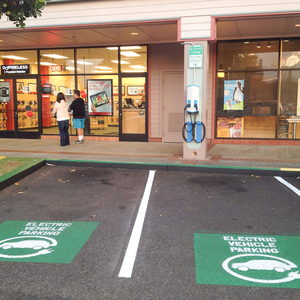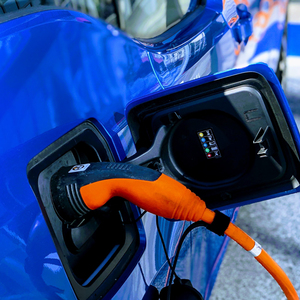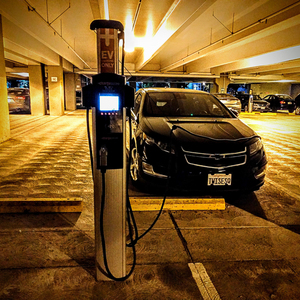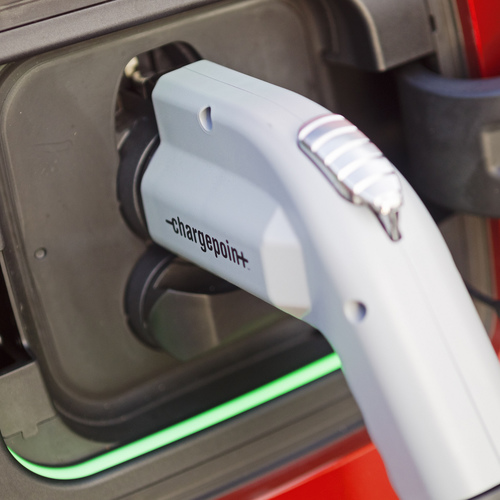
If you are going to drive an electric vehicle (EV), you’re going to have to learn to speak the language of electricity.
Some people think that’s asking too much—that even though you understand units like inches and feet, meters and kilometers, cups and gallons, milliliters and liters, kilobytes and megabytes and gigabytes, you’ll never learn the basic units of electricity. And even though you already have appliances in your house, like hair dryers and microwave ovens, that have the wattage printed right on the front, there are some people who think electricity is just too complicated.
So when it comes to EVs, manufacturers and charging station operators try to dumb it down for you. Instead of telling you the actual power rating of a charging station, they’ll tell you how many miles of range you can get per minute or hour of charging. Instead of telling you the size of your car’s battery pack, they’ll tell you how far it goes on a charge.
The problem is that EVs don’t all go the same distance on a given amount of electricity, and the distance you can go will also depend on the weather, your driving habits, how much you’re using the air conditioning or heater, and other factors. While one EV might go 2.5 miles on a kilowatt-hour, another might go twice that distance. So even though you may learn exactly how far your EV can go on a kilowatt-hour of electricity, that number could be totally different for your neighbor’s EV. Which means that there is no correct and consistent way to say how many miles of range a given charger can deliver per hour of charging time.
It’s better to just learn the units. It’s not hard. Trust me—you can do this! Soon, your children will be learning it in elementary school.
So let’s dive in.
Learning the units
A good way to understand electricity is through water metaphors.
A kilowatt, denoted kW, is a rate of energy flow. It’s like the gallons per minute that a water hose or pump can deliver.
A kilowatt-hour, denoted kWh, is a quantity of electricity, like a gallon. A bigger battery pack with a higher number of kWh will hold more electricity, just as a bigger bucket will hold more gallons of water.
Now let’s put them together.
If you run a 1 kilowatt generator (or EV charging station) for 1 hour, it will deliver 1 kilowatt-hour of electricity. (1 kilowatt multiplied by 1 hour equals 1 kilowatt-hour.)
And that’s it! You’re done! You have learned the electricity units.
OK, let’s test your knowledge now.
If you plug in your EV to a 50 kW charging station, and it runs at full power for one hour, how much energy would it pump into your car’s battery? That’s right: 50 kWh, because 50 kW multiplied by 1 hour equals 50 kWh.
The rate of power that EVs actually get while charging changes depending on how full the battery is. Starting from a low state of charge, a battery will charge at the maximum rate that the vehicle’s charge controller will allow, and then as the battery fills up, it will slow down the rate of charging, until it’s down to a trickle when the battery is almost full. So it’s unlikely that you would get a full 50 kW of power continuously for an hour as in this example. But that’s a technical nuance that you’ll understand as you become accustomed to charging your vehicle.
EV charging stations
Now let’s talk about the different levels of charging stations.
If you just plug an EV straight into a standard U.S. wall outlet (Level 1), without using a charging station, you’ll get about a 1 kW rate of charge.
If you get a home charging station (Level 2) to charge up your car faster, it will probably have a power rating somewhere between 7 kW and 19 kW.
If you use an older public fast-charging station (Level 3 or DCFC), it might deliver 50 kW.
And if you use a state-of-the-art public fast-charging station, it might deliver 150 kW or more.
As you can see, it’s important to understand how fast a charging station is, because the power it delivers might be 150 times faster than just plugging your car into a wall socket.
EV batteries
Now let’s talk about battery sizes.
The 2019 Nissan LEAF, for example, is available with two different battery sizes: 40 kWh and 62 kWh. Suppose you had a 40 kWh model, and you bought a 7 kW home charging station for it. If you started charging it with a completely empty battery (which you would likely never do, but bear with me) and charged it at full speed until it was full, how long would it take to get a full charge? That’s right: about 6 hours (40 kWh divided by 7 kW equals 5.7 hours).
Now how long would it take if you did the same thing, only you did it using a 50 kW fast charger? That’s right: under an hour (40 kWh divided by 50 kW equals 0.8 hours, or 48 minutes).
EV range
Now that you know how to understand charging stations and cars, the only thing left to learn is how to understand your car’s range.
If you had a Tesla Model X, it might go around 2.5 miles on a kilowatt-hour. Suppose you had one with a 100 kWh battery pack. How far could it go on a charge, in theory, if you could use the entire battery? (Again, you probably wouldn’t and couldn’t thanks to certain details I won’t bore you with now.) The answer is 250 miles: 100 kWh multiplied by 2.5 miles per kWh.
Now let’s take the Nissan LEAF with the 40 kWh battery pack again. If you drive it very efficiently under favorable conditions, it can probably go 5 miles on a kilowatt-hour. So what’s its range, in theory? Roughly 200 miles: 40 kWh multiplied by 5 m/kWh.
Thus, the Nissan LEAF with the 40 kWh battery pack can go almost as far on a charge as a Tesla Model X with a battery pack that’s almost twice as large!
Now, let’s try one last test of your new knowledge, and figure out how much range you can get per minute of charging.
Suppose you charged up the Tesla Model X with its 100 kWh battery pack at a 150 kW fast charger at the maximum rate. How many miles of range could you get per minute of charging? Well, 150 kW multiplied by 1 hour is 150 kWh, divided by 60 minutes in an hour, equals 2.5 kilowatt-hours delivered per minute of charging. Multiply that by 2.5 miles of range per kilowatt-hour, and you get 6.25 miles of range per minute of charging.
Now let’s try the same example with the Nissan LEAF. The charger is the same, so you still get 2.5 kilowatt-hours delivered per minute of charging. But the LEAF can go 5 miles on a kilowatt-hour. So 2.5 kWh multiplied by 5 m/kWh equals 12.5 miles of range per minute of charging—double the distance that the Model X could get for charging the same number of minutes. (Intuitively, this makes sense, since the Model X, at 2.5 m/kWh, gets roughly half the fuel efficiency of a LEAF, at 5 m/kWh.)
Now you see why it’s nonsensical to explain the power rating of an EV charger in terms of miles per minute of charging: It depends on the vehicle.
And hopefully you now understand how to speak the language of EVs. Even if it’s unfamiliar at first, try a few of these simple calculations— sing only multiplication and division — and pretty soon you’ll be able to estimate your charging time and your range on a charge like a pro.
Chris Nelder is a manager with the Rocky Mountain Institute’s mobility practice where he leads the EV-Grid Integration initiative. ©2019 Rocky Mountain Institute. Published with permission. Originally posted on RMI Outlet.
Weekly Newsletter
Get building science and energy efficiency advice, plus special offers, in your inbox.















23 Comments
I got one as a former Volt owner...
An EV charging station/spot is not a parking spot. If you're not charging, move your car to make way for others. Far too many EV owners view charging spots as some sort of VIP parking.
Induction charging would fix that although it's probably more expensive to implement.
Also, this is unproductive behavior at charging stations...
It's almost enough to make you want to park the Leaf in front of a diesel pump, eh? :-)
I have a Tesla Model 3. At 90% charged, 292 miles of range. I have only used a plain old 110 outlet to charge, at home. The charge rate is consistently 5 miles of range, per hour of charging. For example, 50 miles of range in 10 hours, nominal. Using AC or heat reduces the nominal amount somewhat of course. I suspect like me, most will do all or almost all their charging, at home, overnight. With a 220 outlet , although I will never need one: about 30 miles of range per hour of charge. It's easier than I suspected it would be.
And ... road trips: Enter destination. Route is mapped, Supercharger stations indicated, travel time displayed, Supercharger top-off times displayed, and status of charging stations free or in-use are updated, in real time. Nothing much to worry about.
"A kilowatt, denoted kW, is a rate of energy flow. It’s like the gallons per minute that a water hose or pump can deliver."
No, it's not. A kilowatt is a unit of power, similar to horse power. Current, in amperes, is similar to gallons per minute as an Amp is defined as a Coulomb per second. And energy is power over time.
" A kilowatt-hour, denoted kWh, is a quantity of electricity, like a gallon. A bigger battery pack with a higher number of kWh will hold more electricity, just as a bigger bucket will hold more gallons of water."
A quantity of electricity is a Coulomb,it's defined as a number of electrons. A kWh is a unit of energy which is an amount of power over time. In this case, a kW used continuously for 1 hour. This is similar to Btu.
I know they're trying to relate common knowledge to electricity unit,but they're just flat out wrong, which doesn't help anyone. Horsepower is a commonly known unit. As are Btu. People are familiar with their BBQ (grill) being capable for say 40,000Btu.
Though I doubt Btus are well understood. Still, it would seem reasonable to make Btu the meeting point, not completely inaccurate information. A gallon (US) of gasoline contains ~114,000Btu, but at best gasoline engines blow over half of that out of the tail pipe and the radiator as heat. (missing the heat rejection of the oil dwelling in the oil pan amd the air cooling around the engine, but it's close enough for the target audience). A kWh is a little more than 3400Btu and an electric car only loses between ⅛ and ¹/10 of their energy to heat loses. So it takes about 16kWh to do the same work as a gallon of gasoline. At $0.12/kWh and $3/gal, that's a savings of over a third.
IMO, "kWh, is a quantity of electricity" should be changed to "kWh, is a quantity of electrical energy" and the rest of it is close enough for the intended purpose (explaining rate vs quantity). It would be more confusing to most with coulombs and amps.
> People are familiar with their BBQ (grill) being capable for say 40,000Btu.
Which is as meaningless as "my car is capable for .35 gallons" (Btu/hr is the correct unit).
Don't encourage anyone to use non SI units.
"Don't encourage anyone to use non-SI units" - I agree completely. I used both SI and imperial units for decades in physics, engineering, and in real life (?), and can say that using SI units leads to far fewer mistakes and misunderstandings. Wish the USA had successfully converted to metric on any of its previous attempts. Slugs? Poundals? Feet? Bah.
I wasn't writing a technical paper or running FEA software, I was trying to show a way the author could expand on their reader's presently held knowledge while also being accurate.
You make me wish this site had a down vote button with just about every post you make. You call people out for doing something incorrectly but you never offer another method. This can be seen with your post here and earlier in this thread, as with many other posts. Please, either don't respond to my posts, or if you're going to correct me, offer what you think is a better way.
As for the non SI units, it is vastly easier to expand on someone's knowledge than to try to teach a completely new subject. Explaining the link between what is familiar with what is new and intimidating is teaching 101. This site caters to Americans, and while I'm not American and I am more familiar with SI units than imperial units, I chose words and ideas that would hopefully resonate with the target audience of the article.
Thank you, Calum! Healthy discussion already here. Now I know SI (French, I reckon?).
Where do volts fit into this matrix?
Thanks for your consideration.
In a hydraulic system, flow rate is analogous to current in electricity, as I explained above. Voltage is analogous to pressure. Or, in an engine/motor current is analogous to rpm, and voltage is analogous to torque.
Notice that in all of those examples power can be calculated by multipling the rate by the intensity and then applying a correction factor. Hp(motor) = rpm × torque(lbft) / 5252, kW = current × voltage , and hp(hydraulic) = flow rate(gpm) × pressure(psi) / 1714 or kW = flow rate(l/min) × pressure(bar) / 600.
Wouldn't flow rate be analogous to power? It tells you how much fluid (energy) is being delivered per unit time. Current seems to be analogous to fluid velocity; without knowing another quantity (voltage or load resistance), it doesn't tell you much of anything.
Voltage : pressure
Current : fluid velocity
Electrical Resistance : flow resistance (equivalent pipe diameter)
Power : flow rate
Energy : flow rate * time
No, power and flow rate aren't the same. Power can be calculated from volume flow rate multiplied by pressure, with a conversation factor, but flow rate is only one part of power. Power is typically calculated in either kW or hp.
Power = intensity * flow rate (pressure * volume flow rate, voltage * current, torque * rpm, etc.)
Energy is power over time. Power is an instantaneous measurement only showing what is happening in a system in a single instant. Energy shows the power usage over a period of time.
Yes, power is an instantaneous measurement. So is flow rate.
You've got something weird going on in your equation:
"Power = intensity * flow rate (pressure * volume flow rate, voltage * current, torque * rpm, etc.)"
First, I don't know what "flow rate" is, if it's different from "volume flow rate". When I said flow rate was analogous to current, I was talking about volume flow rate. The only other flow rate I can think of is mass flow rate, but if you multiply volume flow rate by pressure, that's certainly not what you get.
If you just look at what is inside the brackets, then we clearly agree: voltage is analogous to pressure, and the only other variables are current and volume flow rate.
Looking at it from another angle, let's break this out for the example of electricity. You've got P = Intensity * voltage * current. But voltage times current equals power on its own, so you've got an extra variable in there (intensity). Same thing happens with torque and rpm. So intensity has to be a constant, specifically 1. Once you set that to 1, you see that pressure * volume flow rate are indeed analogous to power.
LMAO, yeah, I see it. I should have written that more clearly.
Power = intensity * flow rate (pressure * volume flow rate, voltage * current, torque * rpm, etc.)
That wasn't meant to be one giant equation. Power is calculated by multipling an intensity by a rate. For example; voltage × current = power. And torque × rpm = power. And another example; pressure × volume flow rate = power. The last two will need a unitless conversion factor to bring it to a useful unit, but that's not important to the present conversion.
>" Power is calculated by multipling an intensity by a rate. "
Huh?
What means "intensity" in your dialect? It doesn't have a standard definition in the physics lexicon, in part because it can be used different ways in different contexts.
Watts could be described an intensity, and it is a unit of power, a rate (joules per second), the intensity at which the energy is flowing.
Watt-hours (or kilowatt-hours) is a unit of energy, and is time independent.
Multiplying the watt "intensity" by a rate would be an acceleration.
Using "intensity" doesn't really clarify anything- too sloppy a term.
I love me some semantics.
I'm not sure the author's original statement is so bad. "A kilowatt, denoted kW, is a rate of energy flow." That seems pretty ok to me. Power is the rate at which work is done / energy flows.
'Flows,' here, needs to be kept distinct from how it is used later in Calum's analogy, which is referencing volumetric flow / flow of charge (not energy).
I can see the trouble with the analogy, "It’s like the gallons per minute that a water hose or pump can deliver." Here I see your points Calum, and generally agree with the water/electricity analogy as you've described.
Though while the authors analogy is not completely accurate, it does somewhat get the point across, given the differences between filling tanks with liquid and charging batteries. All we really care about when filling a tank is the rate of liquid coming out of the nozzle. If we increase power to the pump, it'd track with an increase in volumetric flow because resistance is isolated to the pump system and is constant. The gallons-per-minute spec will tell us how effectively the fuel (energy) will enter our cars.
With batteries, there are significant resistive properties at work for which we need to consider power. Specing only current rating (rate of charge) won't tell us how effective the energy will be transferred.
It'd be analogous to having a bunch of filters in the neck of your gas tank. If that was the case (and we had a sealed nozzle) we would care about the power aspect of the pump.
Your Tesla will tell you exactly how far you can go, live, based on its reading of your energy usage averaged during the drive time extant. It is updated as you drive. If you are a geek and want to dig deeper, the data is buried there, on screen. ICE cars use more energy when running AC, and when it's cold outside. A Tesla will show you in simple terms, exactly where you are at with all that. Electric cars should not be presented as a riddle, they are incredibly simple to use, wonderful to drive, very fast, and will last nearly forever. Maintenance -- almost zero. Tesla put one million miles on their motor and drivetrain, then disassembled, nearly as good as new. Only real world problem will be in trying to find an excuse to buy a new car.
> "At $0.12/kWh and $3/gal, that's a savings of over a third."
Did you mean the cost per mile for an electric car is one third of a gas car?
The link below seems to say EV cost around $0.04/mile, while a 22mpg gas vehicle costs ~$0.12/mile:
https://avt.inl.gov/sites/default/files/pdf/fsev/costs.pdf
An electric car requires no learning curve. The car is a computer on wheels, it will tell you anything you want to know, and alert you to anything you must know. And energy expense is only part of the long term operating expense. One will never replace the brake pads or rotors on an electric car because of regen braking. I use my brakes only to go from 3 to 0 mph, except in panic situations. No radiator to flush, no transmission fluid to change, and on and on.
"That puts the cost of a new Model S driven 150k miles under this simple model at $21,660, which poses the important question “Do you want a Tesla Model S or a Kia Optima?”" ...
https://www.forbes.com/sites/gregautry/2019/02/20/14000-leagues-under-electric-power-my-tesla-cost-me-almost-nothing/#57cfc4dc62f4
Mr. Nelder wrote, "the Model X, at 2.5 m/kWh, gets roughly half the fuel efficiency of a LEAF, at 5 m/kWh." But the EPA lists the MPGe for the Model X at between 79 and 96, and for the Leaf at 112. So I'm confused.
Log in or create an account to post a comment.
Sign up Log in